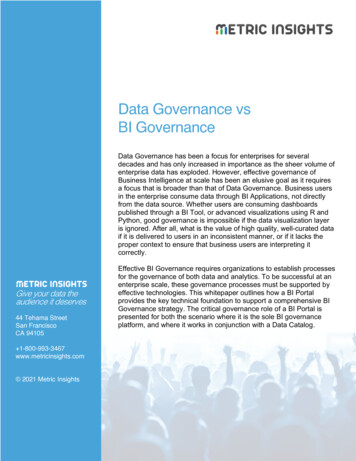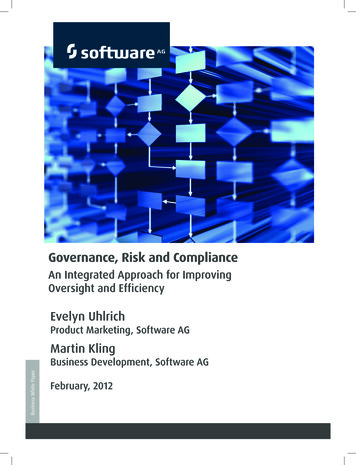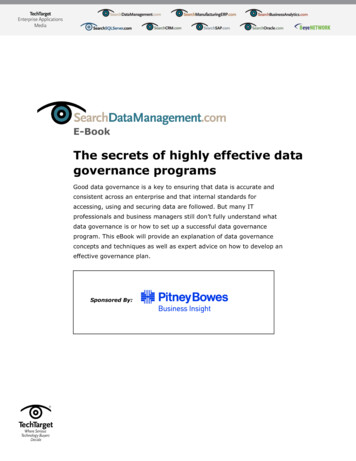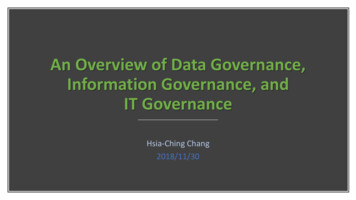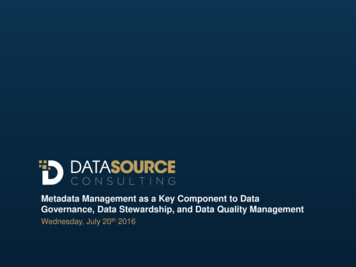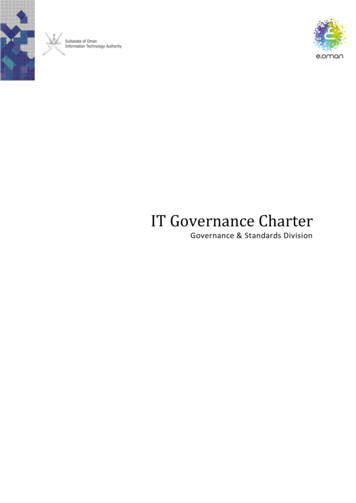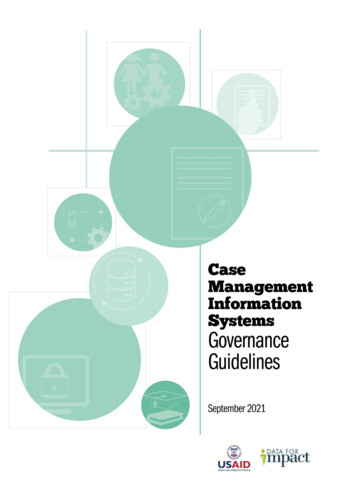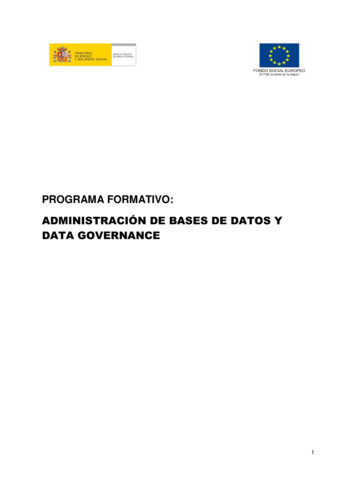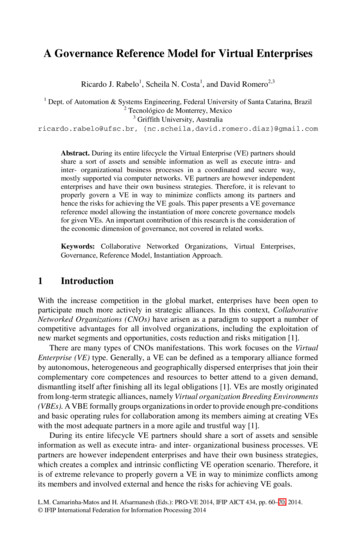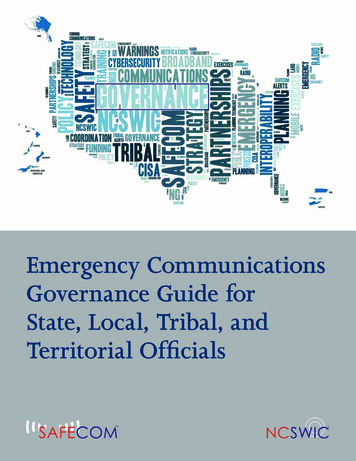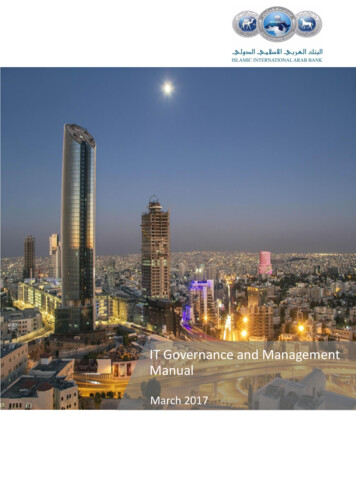
Transcription
IT Governance and ManagementManualMarch 2017
ContentsSection A: IntroductionSection B: Governance andManagement of Enterprise ITFrameworkSection C: RegulatoryCompliance and ReportingSection D: Principles andEnablersSection E: AppendicesPage: 1Page: 3Page: 12Page: 14Page: 17
Section AIntroduction1
1. Introduction1.1 IT Governance and ManagementOverview:The IT Governance and Management Framework atIslamic International Arab Bank (IIAB) is established toensure that IT objectives are aligned with businessobjectives and to meet the stakeholder needs tomaximize value and to create a balance betweenbenefit realizations, risk optimization and zation1.2 IT Governance and Management Objectives:The IT Governance and Management framework aims to achieve the following objectives:1. Align IT goals with business goals.2. Meet stakeholders’ needs by creating a balance between the benefit realization, risk optimization andresources optimization.3. Provide sufficient information and reports to support the decision making process for the governanceand management of enterprise IT.4. Establish effective and prudent IT project management and IT resources management processes.5. Establish technology infrastructure and information systems that enables the banks’ businessstrategies6. Optimize IT risk management to ensure the necessary protection of the Bank’s assets and operations.7. Comply with external and internal regulations and requirements.8. Maximize end user’s satisfaction level of IT services.9. Manage third parties/vendors relationships.2
Section BGovernance and Management ofEnterprise IT Framework3
2. Governance and Management of Enterprise IT at IslamicInternational Arab BankThe following diagram represents the overall framework for the Governance of Enterprise IT at IslamicInternational Arab Bank that is based on CoBIT 5.0 framework and principles:gIIAB Stakeholders NeedsBenefits RealizationRisk OptimizationResource OptimizationGovernance and Management of EnterpriseBoard Commitment to Governance of Enterprise ITPrinciples and Enablers (Pillars)Governance of Enterprise ITEnsure GovernanceFramework Settingand MaintenanceEnsure BenefitsDeliveryEnsure RiskOptimizationEnsure ResourceOptimizationEnsure MonitorMonitorMonitorMonitorGuidelines: IT projectmanagementframeworkGuidelines: IT RiskManagementFrameworkGuidelines: Guiding principlesfor allocation ofresources andcapabilitiesGuidelines: Guiding principlesfor reporting andcommunicationSenior Executive Management Commitment to the BoardGuidelines: IT Governance &ManagementmanualOrganizational StructureIT Governance CommitteeRisk Management CommitteeAudit CommitteeManagement of Enterprise ITPlanBuildRunMonitorOrganizational StructureIT Steering CommitteeRegulatory Compliance and ReportingIllustrative Figure 1: Governance of Enterprise IT Overall Framework4
3. Governance of Enterprise IT:3.1 Board Commitment to Governance of Enterprise IT:Islamic International Arab Bank’s Board is committed to adopting a holistic approach to ensure properGovernance of Enterprise IT. The Board is accountable to Evaluate,Direct and Monitor (EDM) governance processes that entails thefollowing:1. Ensure Governance Framework Setting and Maintenance byendorsing the “IT Governance and Management Manual”;2. Ensure Risk Optimization by endorsing the “IT Risk ManagementFramework”;3. Ensure Resource Optimization by endorsing the “GuidingPrinciples for Allocation of Resources and Capabilities”;4. Ensure Benefits Delivery by endorsing the “Project ManagementFramework”; and,5. Ensure Stakeholder Transparency by endorsing “Guiding Principles for Reporting andCommunication”.3.2 Organization Structure:The following committees are established to support and enable theGovernance of Enterprise IT:1. Risk Management CommitteeRisk Management Committee is responsible for IT Risk Managementand Business Continuity Management.2. Audit CommitteeThe Audit Committee is responsible to provide reasonable assuranceover the compliance with the IT governance framework practices.3. IT Governance CommitteeThe IT Governance Committee is established to support the Board in enabling the Governance ofEnterprise IT practices. The following section includes details on its scope, purpose, members, meetingfrequency, objectives and detailed roles and responsibilities.5
3.3 IT Governance Committee:IT governance committee is established to support the board of directors with regards to the Governanceof Enterprise IT.Scope and purpose: The scope and purpose of the IT Governance Committee is to ensure IT objectivesare in line with the bank’s strategic direction and to ensure that the stakeholders’ needs are met bycreating a balance between benefit realization, risk optimization and resources optimization.Members: The IT Governance Committee is comprised of three board members.Meeting Frequency: The IT Governance Committee meets on a quarterly basis or as required.The IT Governance Committee aims to achieve the following objectives:1.Ensure Governance Framework Setting and Maintenance;2.Ensure Risk Optimization;3.Ensure Resource Optimization;4.Ensure Benefits Delivery; and,5.Ensure Stakeholder Transparency.Roles and Responsibilities:1. To endorse IT strategic goals and appropriate organizational structures including steeringcommittees in a manner that fulfills and achieves strategic objectives and maximizes added value ofIT projects and investments.2. To monitor the realization of strategic objectives through utilizing appropriate tools and standardssuch as IT Balanced Scorecards and Return on Investments (ROI) calculation.3. To endorse the IT governance, processes, projects and resources control, monitoring andmanagement framework that is aligned with leading practises in order to achieve improvedoperational and financial efficiency.4. To endorse an Enterprise IT Goal Matrix that links business and IT related goals & sub goals.5. To endorse the governance and management processes and sub processes roles and responsibilities(i.e. RACI Charts).6. To ensure the availability of an IT Risk Management Framework that is aligned with the EnterpriseRisk Management (ERM) Framework.7. To endorse IT projects and IT resources budgets in alignment with the bank’s strategic goals.8. To monitor and oversee the IT operations, projects and resources to ensure alignment with thebank’s strategic goals and the realization of expected benefits.9. To review the IT audit reports and ensure that corrective actions are implemented to resolvereported deviations.10. To raise necessary recommendations on corrective actions to resolve deviations to the Board ofDirectors.11. To endorse the following principles, standards, frameworks and matrices: IT projects and resources management principles, policies and frameworks.6
IT Risk Management, Information Security Management and Human Resources Managementframeworks. Policies matrix required to manage IT governance and resources along with the policies’development principles, ownership, and scope. Information and reports matrix that defines owners and access privileges according to businessneeds. IT services, programs and infrastructure matrix that supports the IT governance processes. IT services, programs and infrastructure matrix that supports the bank operations. IT Human Resources Policy and Competency Matrix covering the IT governance processesrequired skills in HR Management, Risk Management, Information Security Management, andInternal Audit areas. Further, to ensure that the annual performance evaluation processmeasures the achievement level of the Banks’ goals. A Code of conduct that reflects acceptable IT usage professional & behavioural rules and toensure that proper internal and external audit procedures are available to monitor behaviours.The following diagram represents the IT Governance Committee’s inputs and outputs:OutputInput Directives from Board ofDirectors Recommendations from the ITSteering Committee Enterprise IT Goal Matrix (i.e.linked business & IT goals) IT projects and IT resourcesmanagement framework IT Governance and ManagementManual RACI Charts Enterprise Risk Management(ERM) framework and IT RiskManagement framework IT Budgets (Capex and Opex) IT Audit Reports Principles,standards,frameworks andmetriciesBoard of DirectorsIT GovernanceCommittee Endorsed Enterprise IT GoalMatrix (i.e. linked business & ITgoals) Endorsed IT projects and ITresources managementframework Endorsed IT Governance andManagement Manual Endorsed RACI charts Endorsed IT Risk ManagementFramework Endorsed budget (i.e. capex,opex, and strategic projects) Endorsed audit findingsresolution plan Recommendation to the Boardof Directors. Endored principles, standards,frameworks and metriciesIllustrative Figure 2: IT Governance Committee Inputs and Outputs7
4. Management of Enterprise IT:4.1 Senior Executive Management Commitment to the Board:Senior Executive Management is responsible for implementing the Board’s vision and strategy by:1. Aligning, planning and organizing IT goals and initiatives asindicated by the Board’s strategic direction and vision forbusiness and IT;2. Building, acquiring and implementing needed infrastructure,applications and services.3. Running and maintaining the established business services.4. Monitoring, evaluating, and assessing the performance andcompliance of all the IT related processes, practices andactivities.4.2 Organizational Structure:The IT Steering committee is established to support the IT Governance Committee to enable theGovernance of Enterprise IT. The following section includes detailson its scope, purpose, members, meeting frequency, objectives anddetailed roles and responsibilities.8
4.3 IT Steering Committee:The IT Steering Committee is established to support the IT Governance Committee in relation to theManagement of Enterprise IT implementation practices.Scope and Purpose: The scope and purpose of the IT Steering Committee is to ensure business and ITalignment and create a balance between benefit realization, resources optimization and IT riskoptimization.Members: The IT Steering Committee is comprised of the following members: General Manager (chair of the committee); Chief of Business and Investment; Chief of Support and Operations; Chief of Risk Management; Head of Information Technology; Head of Operations; Information Security and Business Continuity Manager; Head of Enterprise Project Management Office & Enterprise Architecture; and, Two observers, which include a Board member and Head of Internal Audit.Meeting Frequency: The IT Steering Committee meets on a quarterly basis or as required.The IT Steering Committee aims to achieve the following objectives:1.2.Ensure IT strategic goals are achieved.Ensure IT programs/project are properly prioritized and executed in alignment with their businessstrategic purpose(s).3. Optimize usage of IT resources.4. Ensure IT risk optimization.Roles and Responsibilities:1. To manage and oversee the implementation of the IT Governance and Management requirements.2. To approve IT annual plans required to achieve the bank’s strategic objectives and to continuallymonitor the internal and external factors that may affect their completion.3. To link and regularly review the Enterprise Goals Matrix with the related IT Goals Matrix to ensurethe achievement of the bank’s strategic objectives.4. To define a set of metrics to measure goals achievement and to assign members from the SeniorExecutive Management to continuously monitor it and report to the committee.5. To recommend financial and non-financial resources to acquire appropriate infrastructure andservices that are required to achieve IT governance objectives. Further, to supervise IT Governanceprojects’ and processes’ implementation activities.6. To endorse & prioritize the annual IT programs and projects.7. To monitor IT services performance and provide recommendations to improve its effectiveness andefficiency.8. To report necessary recommendations to the IT Governance Committee, on the following: Resources and enablers to achieve IT governance committee roles. Deviations that may adversely affect the achievement of strategic objectives.9
Unacceptable IT and IS risks. IT projects’ and resources’ framework performance and compliance reports.9. To develop information systems and infrastructures required to provide information/reports thatsupports the IT decision making process and to define requirements for the integrity, confidentialityand availability of information/reports based on the data classification guidelines adopted by thebank and CoBIT 5.0 guidelines (CoBIT 5 – Enabling Information).10. To approve the IT services, programs, and infrastructures matrix required to support the ITGovernance and Management processes.11. To approve the IT services, programs, and infrastructures matrix as detailing minimum requirementand endorse it by the Board or its mandated committees. Further, this matrix should be updatedcontinuously to accommodate the bank’s goals and processes development.12. To report to the IT Governance Committee through formal minutes of meeting.13. To review and update the committee roles and responsibilities annually. The following diagram represents the IT Steering Committee’s typical inputs and outputs:InputOutput Mandates from the ITGovernance Committee Enterprise IT goals IT Strategic plan Key Performance Indicators andInformation/reports matrices IT budget (i.e. Capex and Opex)& resources requirements Strategic IT projects portfolio IT Services improvement plan Data classification guidlines IT services, programs andInfrastructure matrix. Committes’ roles andresponsiblities Recommended Enterprise ITGoal Matrix (i.e. linkedbusiness & IT goals) Recommended IT strategicplan and related annualplans Recommended KeyPerformance Indicators andInformation/reportsmatrices Recommended IT budget &resources requirements Endorsed prioritized ITstrategic projects portfolio Endrosed IT servicesimprovement plan Endrosed data classificationguidlines Endorsed IT services,programs and Infrastructurematrix. Committes’ roles andresponsiblities Recommendations to the ITGovernance Committee.IT Governance CommitteeIT SteeringCommitteeIllustrative Figure 3: IT Steering Committee Inputs and Outputs10
Section CRegulatory Compliance andReporting11
5. Regulatory Compliance and Reporting5.1 The Board’s Commitment to regulatory compliance:The Board is responsible to ensure that Governance and Management of Enterprise IT practices isestablished in line with the CBJ’s IT Governance and Managementregulation (Regulation No: 65/2016) issued on 25/10/2016.Additionally, the Board shall ensure that Islamic International ArabBank complies with the applicable IT related requirements ofexternal laws, regulations and instructions as well as internal policiesand procedures derived from external laws and regulations.5.2 Reporting:5.2.1 Annual ReportingThe Bank shall disclose the existence and compliance with the “IT Governance and ManagementManual” within the Bank’s annual report and shall ensure that it is formally updated at regular intervalsor when required.5.2.2 Internal Audit ReportingThe Internal Audit Department shall: Conduct risk based IT audits and report to the IT Governance Committee on the effectiveness of theIT Governance Framework in alignment with the CBJs IT Governance and Management regulation(Regulation No: 65/2016). Ensure that the audit charter scope includes IT Governance and Management processes in line withthe CBJ regulation (Regulation No: 65/2016). Comply with the latest version of IT Assurance Framework International Standard (ITAF) issued byInformation System Audit and Control Association (ISACA).5.2.3 The Audit CommitteeThe Audit Committee will provide the CBJ with the annual IT audit report during the first quarter ofevery year.5.2.4 External Audit ReportingThe Bank’s external auditor shall perform risk based independent review(s) of the IT Governance andManagement processes, and shall report to the CBJ on the effectiveness of implemented controls. The Bank’s external auditor shall comply with the latest version of IT Assurance FrameworkInternational Standard (ITAF) issued by ISACA. 12
Section DPrinciples and Enablers13
6. Principles & Enablers (Pillars)6.1 Principles of IT Governance and Management:Core principles of Islamic International Arab Bank’s IT governance and management system are built onthe COBIT 5.0 Governance of Enterprise IT principles as follows:1. Meeting the stakeholder needs by creating value forstakeholders and by maintaining a balance between riskoptimization, resource utilization and realization of benefits.2. Separating governance and management responsibilities bydifferentiating between each level’s roles and responsibilitiesand related committees.3. Covering the Bank from end to end which includes requires thecommitment of the Board and Senior Executive Management asfollows: The Board level via establishing a stable IT governancesystem and scope with the objective to achieve stakeholderneeds. The Senior Executive Management level via implementing Board level directions to achieve thethe agreed on goals and by reporting to the Board on the execution progress and monitoringactivities.4. The application of a single integrated framework in alignment with relevant international standardsand leading practices.5. Enabling a holistic approach to IT governance and management through the provisioning anddevelopment of 7 enablers which include: Principles, policies, and frameworks; Processes; Organization Structures; Culture, Ethics, and Behaviour; Information; Services, Infrastructure, and Applications; and, People, Skills, and Competencies.14
6.2 Enablers (Pillars)The following represents the key enablers that support Islamic International Arab Bank’s IT Governance& Management system:Enabler 1: Principles, Policies, and FrameworksThe Board shall express the bank’s core values via its “principles”,“policies” and “framework” that are made available to provide itsaudience with detailed guidance on how to apply the principles intopractices. Further, “principles”, “policies” and “framework” shall beeffective & efficient and shall include compliance, management andupdate requirements.Enabler 2: ProcessesThe Board or mandated committees shall endorse governanceprocesses objectives derived from the Bank’s policies, procedures,frameworks, enterprise goals and related IT related goals.Enabler 3: Organizational StructuresThe Board or mandated committees shall endorse Organizational Structures and related committees toachieve IT governance objectives, these structures should clearly illustrate delegation of authority,escalation procedures, decision-making process and segregation of incompatible duties.Enabler 4: Culture, Ethics, and BehaviorThe Board or mandated committees shall endorse an enterprise code of conduct that reflects theprofessional and ethical rules in alignment with acceptable international behaviour rules. This code shallclearly state the desirable and undesirable behaviours and consequences of conduct. Further, the boardor Senior Executive Management shall employ diversified mechanisms to encourage desirablebehaviours and to avoid undesirable behaviours.Enabler 5: InformationThe Board or mandated committees shall endorse an information and reporting matrix, with assignedowners responsible to authorize access to these information/reports based on business needs. Inaddition to, ensure that information/reports are regularly updated to accommodate the enterpriseobjectives and processes improvement in alignment with international leading practices.Enabler 6: Services, Infrastructure, and ApplicationsThe Board or mandated committees shall endorse appropriate services, infrastructure and applicationsto support governance practices and processes.Enabler 7: People, Skills, and CompetenciesThe Board or mandated committees shall endorse a competency matrix and human resources policiesrequired to achieve IT governance processes requirements.15
Section EAppendices16
Appendix I: DefinitionsThe following terms shall have the meanings respectively assigned to them herein below:1. Governance of Enterprise IT: is defined as the processes that ensure the effective and efficient useof IT in enabling an organization to achieve its goals.2. COBIT: Control Objectives for Information and related Technology – a good-practice businessframework developed by ISACA (Information Systems Audit and Control Association) for thegovernance and management of IT.3. The Board: The Board of Directors of the Bank.4. Management: A body comprised of Senior Executive Management responsible for planning,building, running, and monitoring activities in alignment with the direction set by the governancebody to achieve enterprise objectives.5. Assets: are defined as any resource or any quality that has value to the bank (e.g. hardware,information, infrastructure, people, resources and outsourced services).6. IT Governance Committee: A group of appointed individuals comprising of 3 board members thathas the overall responsibility to govern Information Technology (IT) activities and align them to thebank’s strategic direction.7. IT Steering Committee: A group of appointed individuals comprising of the CEO (chair of thecommittee), deputy CEO, Chief Operating Officer, Chief Risk Officer, Head of IT, and observerswhom of which include one board member and Head of Internal Audit. This committee has theoverall responsibility of providing recommendations, decision making, driving IT related initiatives toensure business and IT alignment, and optimize value from IT resources and optimize IT risks.8. COBIT 5.0 Five Principles: Five principles that allow the enterprise to build an effective governanceand management framework based on a holistic set of seven enablers that optimizes informationand technology investment and use for the benefit of stakeholders. These 5 principles include: Meeting the stakeholders needs. Covering the enterprise end-to-end. Applying a single integrated framework. Enabling a holistic approach. Separating governance from management.9. COBIT 5.0 Seven Enablers: 7 enablers/factors that individually and collectively influence theenablement of COBIT 5.0 processes. These 7 enablers include: Principles, policies, and frameworks. Processes. Organizational Structures. Culture, ethics, and behaviour. Information. Services, infrastructure, and applications. People, skills, and competencies.17
bank and CoBIT 5.0 guidelines (CoBIT 5 – Enabling Information). 10. To approve the IT services, programs, and infrastructures matrix required to support the IT Governance and Management processes. 11. To approve the IT services, programs, an
